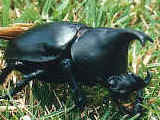
- Christmas Beetles - picture taken on Boxing Day
- Their larvae are grub-liked, always live in concealed habitats, feeding on roots, dung or decaying plants materials. They are sluggish, cylindrical, c-shaped, with a well-developed head and legs. Since they live usually next to the food source and they seldom need to move.
- We found many different species of Scarab Beetles, they are listed in subfamilies as follows;
 Subfamily Melolonthinae - Chafers
Subfamily Melolonthinae - Chafers- Their life cycle is usually more than one year. Larvae are C-shaped and soil-dwelling, feed on roots and other organic matter. They pupate in cell deep in soil. When become adults, they stay remains in the cell, wait until rain softens the soil and come out. This makes the adults come out from soil in the same time, synchronizes as the mating flight. Most of them active at night but some feed during the day.
 Subfamily Rutelinae
Subfamily Rutelinae- Adults feed and mate on tree during the day, lay eggs in soil or under fallen bark and logs. Their life cycle is usually more than one year. Larvae are C-shaped and soil-dwelling, feed on roots and other organic matter. They pupate in cell deep in soil. Some genus in this subfamily are known as Christmas Beetles, huge number appear during Christmas days in Australia. They hang on tree just like the decorations on Christmas tree.
 Subfamily Dynastinae
Subfamily Dynastinae- Beetles in this subfamily are stout bodied, usually black or dark brown in colour. Males and females may look different in this subfamily. Males bear horns which are disproportionately large. Adults do not feed on leaves and are active at night. Larvae live in soil feed on roots or decaying plant matter or rotten logs.
 Subfamily Cetoniinae - Flower Beetles
Subfamily Cetoniinae - Flower Beetles- Beetles in this subfamily are some what flattened, some are metallic in colour. They active during the day, most are seen feeding on flowers. Adults' mouth-parts are modified for nectar feeding. They are active flyer, can fly rapidly by spreading their wings without raising the elytra. Larvae live in soil and feed on rotten wood or decaying plant materials.
- Reference:
- 1. Insects of Australia, CSIRO, Division of Entomology, Melbourne University Press, 2nd Edition 1991, p 627.
- 2. Insects of Australia and New Zealand - R. J. Tillyard, Angus & Robertson, Ltd, Sydney, 1926, p228.
- 3. Beetles of Australia - Trevor J Hawkeswood, Angus & Robertson Publishers, 1987, p31.
- 1. Insects of Australia, CSIRO, Division of Entomology, Melbourne University Press, 2nd Edition 1991, p 627.
Scarab Beetles - FAMILY SCARABAEIDAE
The beetles in this family are usually medium to large size, occasionally with bright colour. They have distinctive lamellate antennae which opens like a small fan and they can close it together as a compact club. Beetles in other families may have the similar lamellate antenna but they cannot close it. Legs, especially the fore coaxes, are usually shaped good for digging. Adults beetles usually feed on leaves and flowers. Most of them have functional wings and are active flyers.
